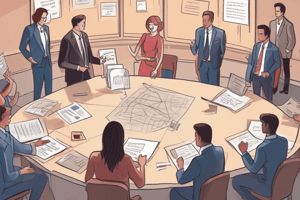Podcast
Questions and Answers
What motivates employees to work in teams?
What motivates employees to work in teams?
- The drive to bond with fellow team members and fulfill group goals (correct)
- Fear of traditional supervisor
- Competition with other teams
- Higher salary and benefits
What is the outcome when employees work near others in a team?
What is the outcome when employees work near others in a team?
- Performance improves due to co-workers being benchmarks of comparison (correct)
- Decreased performance
- No impact on performance
- Only the team leader's performance improves
What is the principle that adding more people to a late software project makes it later?
What is the principle that adding more people to a late software project makes it later?
- Team Design Principle
- Process Losses Principle
- Brook's Law (correct)
- Social Capital Theory
What do informal groups potentially minimize in the workplace?
What do informal groups potentially minimize in the workplace?
What is an important source of trust building, information sharing, power, influence, and employee well-being in the workplace?
What is an important source of trust building, information sharing, power, influence, and employee well-being in the workplace?
What is the term for the resources expended toward team development and maintenance rather than the task?
What is the term for the resources expended toward team development and maintenance rather than the task?
What is the primary reason why team members tend to work together more effectively?
What is the primary reason why team members tend to work together more effectively?
What is the problem that occurs when people exert less effort when working in teams than when working alone?
What is the problem that occurs when people exert less effort when working in teams than when working alone?
What is the ideal team size according to the text?
What is the ideal team size according to the text?
What is the key characteristic of effective team members, according to the 'Five C' model?
What is the key characteristic of effective team members, according to the 'Five C' model?
What is the primary factor that influences team effectiveness in virtual teams?
What is the primary factor that influences team effectiveness in virtual teams?
What is the primary benefit of high-performance teams, according to the text?
What is the primary benefit of high-performance teams, according to the text?
What is the main reason individual team members may refrain from sharing their ideas?
What is the main reason individual team members may refrain from sharing their ideas?
What is the term for when team members prioritize consensus over making a high-quality decision?
What is the term for when team members prioritize consensus over making a high-quality decision?
What is a characteristic of Self-Directed Teams (SDTs)?
What is a characteristic of Self-Directed Teams (SDTs)?
What can happen to a team member who expresses a dissenting opinion?
What can happen to a team member who expresses a dissenting opinion?
Why do team members sometimes question their own opinions?
Why do team members sometimes question their own opinions?
What is a benefit of team cohesion?
What is a benefit of team cohesion?
Flashcards are hidden until you start studying
Study Notes
Informal Groups
- Informal groups are the backbone of social networks in the workplace, promoting trust building, information sharing, power, influence, and employee well-being.
- They increase social capital, which refers to the knowledge and resources available to people through a durable network of connections.
- Informal groups can minimize employee stress by providing emotional and informational support.
Teams
- Teams can make better decisions, develop better products and services, and create a more engaged workforce than individual employees.
- Employees are more motivated when working in teams because they are accountable to their fellow team members.
- Performance improves when employees work together, as coworkers become benchmarks for comparison.
Challenges of Teams
- Process losses occur when resources are expended on team development and maintenance rather than the task itself.
- Brook's Law states that adding more people to a late software project only makes it later.
- Social loafing is the problem of individuals exerting less effort when working in teams than when working alone.
Team Design
- Task characteristics determine what type of work is best suited for teams.
- Task interdependence refers to the extent to which team members must share materials, information, or expertise to perform their jobs.
- Team size should be large enough to provide necessary competencies and perspectives, yet small enough to maintain efficient coordination and meaningful involvement of each member.
Team Effectiveness
- Team composition is critical, with effective team members possessing the "Five C" characteristics.
- Team effectiveness relies on the satisfaction and wellbeing of its members, including team variability and the ability to survive.
- Leaders play a crucial role in high-performance teams, providing support and strategic decision-making while team members focus on operational efficiency and flexibility.
Decision-Making Problems
- Evaluation apprehension occurs when individuals are reluctant to share ideas due to fear of being judged by others.
- Pressure to conform can lead to team members suppressing dissenting opinions, and may also be subtle, influencing individuals to conform to team norms.
- Group think occurs when highly cohesive groups value consensus over decision quality.
Self-Directed Teams
- Self-Directed Teams (SDTs) are cross-functional work groups that complete an entire piece of work, requiring several interdependent tasks, and have substantial autonomy over execution.
- Two distinctive features of SDTs are that they complete an entire piece of work and have substantial autonomy.
Studying That Suits You
Use AI to generate personalized quizzes and flashcards to suit your learning preferences.




